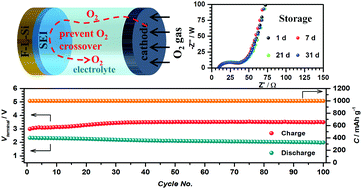A long-life lithium ion oxygen battery based on commercial silicon particles as the anode†
Abstract
Lithium–oxygen (Li–O2) batteries with Li metal as anodes suffer from serious safety problems because of the formation of Li dendrites during the discharge and charge cycles. In this study, for the first time, we developed a long-life Li ion O2 battery based on commercial silicon particles as a substitute for Li metal as the anode. This was realized after determining the detailed cause of the fading performance of these batteries based on unoptimized Si anodes. The batteries can achieve as many as 100 discharge–charge cycles with low overpotentials, indicating excellent cycling stability. The durable solid electrolyte interphase (SEI) film built on the silicon anode surface was proved to play a critical role. The composition of the SEI film grown in glyme-based electrolyte was originally analyzed, and the resulting strong resistibility of the unique SEI film towards oxygen crossover effects endows these batteries with stable cycling ability. Moreover, a storage experiment confirmed the potential long-term operation of these batteries. These encouraging results imply an accessible solution to address problems related to Li metal for the realization of practical Li–O2 batteries.


 Please wait while we load your content...
Please wait while we load your content...